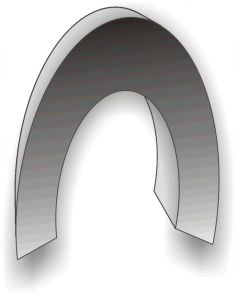 Classroom management, seating arrangements - annyira újkeletű szakmai kifejezésnek tűnnek sokak számára, hogy gyakran épp az új ötletektől való félelem fojtja meg a hatékony óra megtartására tett hatalmas erőfeszítéseinket.
Classroom management, seating arrangements - annyira újkeletű szakmai kifejezésnek tűnnek sokak számára, hogy gyakran épp az új ötletektől való félelem fojtja meg a hatékony óra megtartására tett hatalmas erőfeszítéseinket.
Ez alkalommal az osztályterem elrendezésének lehetőségeit nézzük meg, csak néhányat, ízelítő gyanánt:
Five Common Seating Arrangements
1. Desks in rows, facing forward. Proponents of this arrangement say that whe n all the students are facing forward, there is less talking and all students are able to see the whiteboard.
n all the students are facing forward, there is less talking and all students are able to see the whiteboard.
2. Desks in groups. The groups can be in two, four or six, with six usually the high number. When a group is larger than six, it interferes with the group dynamics and students splinter off into smaller informal groups of two or three. If grouping for cooperative work is the goal, then the number of students in the group should equal the number of tasks or jobs for cooperative work.

3. Horsheshoe shape. In this arrangement, two rows of desks are facing each other from opposite sides of the room, and one row faces forward toward the whiteboard. This allows for communication between all members in the class, and is perfect for class sizes of 20 or fewer students.
4. L shape arrangements. Two desks are placed at a right angle to two other  desks. This desk configuration creates groups of four students that can work together cooperatively. In a small space, the L shape may be tessellated through the room with no space between the groups. This allows for a wide center aisle in an otherwise crowded room.
desks. This desk configuration creates groups of four students that can work together cooperatively. In a small space, the L shape may be tessellated through the room with no space between the groups. This allows for a wide center aisle in an otherwise crowded room.
5. U shape arrangement. The desks are arranged in a U across the room, allowing all the students to see each other. This is similar to the horseshoe shape and is an excellent choice for classes that have class meetings for social development.
Szóval semmi spanyolviasz, de sokan addig nem is hiszik el, hogy mekkora változást képes előidézni az óra hatékonyságában egy kis tereprendezés, amíg ki nem próbálják - persze csak ésszel!

 Classroom management,
Classroom management,  n all the students are facing forward, there is less talking and all students are able to see the whiteboard.
n all the students are facing forward, there is less talking and all students are able to see the whiteboard.
 desks. This desk configuration creates groups of four students that can work together cooperatively. In a small space, the L shape may be tessellated through the room with no space between the groups. This allows for a wide center aisle in an otherwise crowded room.
desks. This desk configuration creates groups of four students that can work together cooperatively. In a small space, the L shape may be tessellated through the room with no space between the groups. This allows for a wide center aisle in an otherwise crowded room.
 Ha még mindig úgy érzeitek, hogy nem elég az a 100 téma az előző posztból, hogy megálmodjátok, mi legyen a nyitó/bemelegítő beszélgetés
Ha még mindig úgy érzeitek, hogy nem elég az a 100 téma az előző posztból, hogy megálmodjátok, mi legyen a nyitó/bemelegítő beszélgetés 




 Na tehát, kedves MADve(zérlőpult) technikai komám alkotott valami maradandót a világnak, mégpedig a fentebb látható ARCOOOOOT meg az egész szépséget!!!!! (Aztán ő is biztos átment usb-be...)
Na tehát, kedves MADve(zérlőpult) technikai komám alkotott valami maradandót a világnak, mégpedig a fentebb látható ARCOOOOOT meg az egész szépséget!!!!! (Aztán ő is biztos átment usb-be...)